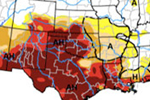
Children stand in sweet potato fields in Indonesian New Guinea. A new report finds that poor and small-holding farmers are most vulnerable to the impacts of climate change. Photo by: Rhett A. Butler.
Growing, transporting, refrigerating, and wasting food accounts for somewhere between 19-29 percent of the world’s greenhouse gas emissions in 2008, according to a new analysis by the CGIAR Research Program on Climate Change, Agriculture and Food Security (CCAFS). In hard numbers that’s between 9.8 and 16.9 billion tonnes of carbon dioxide, more than double the fossil fuel emissions of China in the same year. Over 80 percent of food emissions came from production (i.e. agriculture) which includes deforestation and land use change.
“We are coming to terms with the fact that agriculture is a critical player in climate change,” Frank Rijsberman, the CEO of the CGIAR Consortium, said in a press release. “Not only are emissions from agriculture much larger than previously estimated, but with weather records being set every month as regional climates adjust and reset, there is an urgent need for research that helps smallholder farmers adapt to the new normal.”
While researchers have long estimated the climate costs of food production, this is the first analysis that attempts to take the entire food industry into account.
“It includes manufacture of inputs like fertilizers, then agriculture itself, but also food distribution and sales, use of food in the home, and how food waste is managed,” the report’s lead author, Sonja Vermeulen, told the Inter Press Service in an interview, dubbing this approach from “‘fertilizer to fork.'”
The analysts note that climate change may produce winners and loser throughout the agricultural system. Some crops may have to abandoned regionally as warming continues, while other crops may see expansion. However, the report warns that food security, especially for the world’s poor, will likely be undercut in a warming world.
“The principal concern for food systems under climate change is their reduced capacity to assure food security to poor populations vulnerable to hunger and malnutrition,” the scientists write.
According to the UN around one-in-eight people currently suffer from malnutrition or around 870 million. Climatologists have increasingly linked the rise in some extreme weather events—especially heatwaves, droughts, and floods—to global warming. Such events can have devastating impacts on regional and even global agriculture, as the record drought in the U.S. this year attests.
Related articles
One in eight people suffer from malnutrition worldwide

(10/16/2012) In a world where technology has advanced to a point where I can instantly have a face-to-face conversation via online video with a friend in Tokyo, nearly 870 million people, or one in eight, still suffer from malnutrition, according to a new UN report. While worldwide hunger declined from 1990 to 2007, progress was slowed by the global economic crisis. Over the last few years, numerous and record-breaking extreme weather events have also taken tolls on food production. Currently, food prices hover just below crisis levels.
Food prices rise as food aid needed in Middle East and Africa
(10/04/2012) Food prices increased in September on the FAO Food Price Index after two months of stability, while food aid has been urgently called for in Yemen and Syria, and concerns lingered in parts of Africa. Food prices globally rose 3 points (or 1.4 percent) to 216 points.
Agriculture causes 80% of tropical deforestation

(09/27/2012) Agriculture is the direct driver of roughly 80 percent of tropical deforestation, while logging is the biggest single driver of forest degradation, says a new report funded by the British and Norwegian governments. The report presents an overview of drivers of deforestation to inform policymakers involved in developing the REDD+ mechanism, an international program that aims to reduce emissions from deforestation and forest degradation.
Drought drives corn prices to record high
(08/09/2012) Drought in America’s Midwest drive corn prices to record highs on Thursday.
Climate change increased the probability of Texas drought, African famine, and other extreme weather

(07/11/2012) Climate change is here and its increasing the chances for crazy weather, according to scientists. A prestigious group of climatologists have released a landmark report that makes the dramatic point that climate change is impacting our weather systems—and in turn our food crops, our economies, and even our lives—here-and-now. The new report in the American Meteorological Society is first of what is intended to be an annual offering that will attempt to tease out the connections between climate change and individual extreme weather events, such as heatwaves, droughts and floods.
Pastures, not forest, are best place for oil palm expansion in Colombia
(07/11/2012) Colombia is targeting a six-fold increase in crude palm-oil production by 2020. Conservationists fear this may compromise the nation’s natural ecosystems, but a new study suggests the impact may be minimized by limiting new oil palm plantations to certain areas of pasture land.
Agricultural area larger than Texas has been ‘land-grabbed’
(06/26/2012) Compiling over 1,000 foreign land deals from 2000-2010, a new report finds that 702,000 square kilometers (271,043 square miles) of agricultural land worldwide has been sold-off to foreign governments or international corporations, an area larger than Texas. The report by the Worldwatch Institute finds that such land deals, often referred to as “land grabbing,” have declined since a peak in 2009, but still remain high.